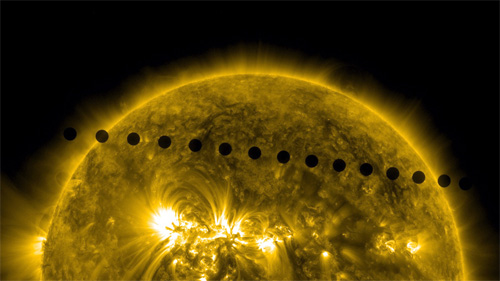
Once in a life-time view: 2012 Transit of Venus
June 07, 2012
Transits of Venus are very rare, coming in pairs separated by more than a hundred years. This June's transit, the bookend of a 2004-2012 pair, won't be repeated until the year 2117. Fortunately, the event was widely visible. Observers on seven continents, even a sliver of Antarctica, were in position to see it.
In this composite image provided by NASA, the SDO satellite captures the path sequence of the transit of Venus across the face of the sun at on June 5-6 as seen from space. The last transit was in 2004 and the next pair of events will not happen again until the year 2117 and 2125.
Venus was the key, according to astronomer Edmund Halley. He realized that by observing transits from widely-spaced locations on Earth it should be possible to triangulate the distance to Venus using the principles of parallax. The idea galvanized scientists who set off on expeditions around the world to view a pair of transits in the 1760s. The great explorer James Cook himself was dispatched to observe one from Tahiti, a place as alien to 18th-century Europeans as the Moon or Mars might seem to us now. Some historians have called the international effort the "the Apollo program of the 18th century." In retrospect, the experiment falls into the category of things that sound better than they actually are. Bad weather, primitive optics, and the natural "fuzziness" of Venus’s atmosphere and other factors prevented those early observers from gathering the data they needed. Proper timing of a transit would have to wait for the invention of photography in the century after Cook’s voyage. In the late 1800s, astronomers armed with cameras finally measured the size of the Solar System as Edmund Halley had suggested. This year’s transit was the second of an 8-year pair. Anticipation was high in June 2004 as Venus approached the sun. No one alive at the time had seen a Transit of Venus with their own eyes, and the hand-drawn sketches and grainy photos of previous centuries scarcely prepared them for what was about to happen. Modern solar telescopes captured unprecedented view of Venus’s atmosphere backlit by solar fire. They saw Venus transiting the sun’s ghostly corona, and gliding past magnetic filaments big enough to swallow the planet whole.
Edited by Mary Kauffman, SitNews
Source of News:
E-mail your news &
photos to editor@sitnews.us
|
||
